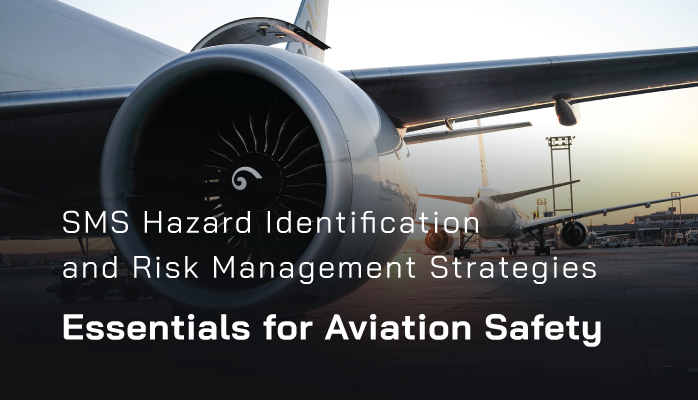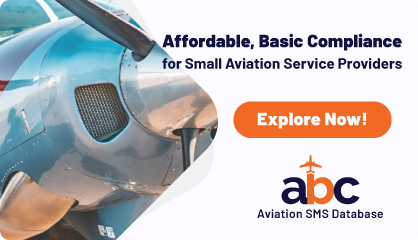SMS Hazard Identification & Risk Management Strategies

For aviation safety managers and accountable executives, implementing an effective Safety Management System (SMS) is critical to identifying hazards, managing risks, and ensuring compliance with global standards like those set by the International Civil Aviation Organization (ICAO).
This article explores practical tools and strategies for hazard identification and risk management within an SMS, offering actionable insights to enhance safety and operational resilience. Whether you're overseeing a commercial airline, a regional operator, or a maintenance organization, mastering these SMS essentials will empower you to proactively control risks and foster a culture of safety. Let’s dive into the core components and practical tools that make hazard identification and risk management both effective and sustainable.
Why SMS Matters in Aviation Safety
A Safety Management System is a systematic top down approach to managing safety risks in aviation. Mandated by ICAO and adopted by regulatory bodies like the FAA and EASA, an SMS integrates people, processes, and technology to identify hazards, assess risks, and implement controls. The goal? To prevent accidents, reduce incidents, and ensure continuous improvement.
For safety managers and executives, the SMS is more than a compliance requirement—it’s a framework for building trust with regulators, employees, and passengers. Effective hazard identification and risk management are the backbone of this system, enabling organizations to stay ahead of potential threats in a dynamic industry.
Related Aviation Hazard Identification Articles
- Safety Chart: Monitoring Hazard Identification and Safety Reporting Culture Per Division
- FAA Part 5 Compliance | Safety Risk Management Hazard Identification Requirement
- How to Be Compliant With ICAO Hazard Identification
Step 1: Hazard Identification – The Foundation of SMS
Hazards are conditions or situations with the potential to cause harm, such as equipment failures, human errors, or environmental factors. Identifying hazards is the first step in an SMS, and it requires a proactive, data-driven approach. Here are practical tools and strategies to excel in hazard identification:
1.1 Safety Reporting Systems
Encourage a non-punitive safety reporting culture where employees feel safe to report hazards without fear of reprisal. Tools like electronic safety reporting platforms (e.g., SMS Pro's Safety Reporting System or proprietary software) allow frontline staff—pilots, technicians, and ground crew—to submit reports on near-misses, equipment issues, or procedural gaps.
-
Practical Tip: Use mobile-friendly reporting apps to increase accessibility. Regularly analyze reports to identify recurring trends, such as frequent runway incursions or maintenance delays.
1.2 Safety Audits and Inspections
Conduct regular safety audits and walkaround inspections to proactively identify hazards. Audits should cover operational areas like flight operations, ground handling, and maintenance, while inspections focus on physical assets like aircraft, tools, and facilities.
- Practical Tool: Use checklist-based audit software (e.g., SMS Pro or ABC) to standardize inspections and track findings. Ensure checklists are aligned with ICAO Annex 19 and local regulations.
- Example: A maintenance audit might reveal improper storage of hazardous materials, a latent hazard that could lead to chemical exposure or fire risks.
Related Aviation SMS Audit Articles
- How Often Should You Conduct Aviation SMS Audit
- 9 Best Strategies for Aviation Safety Audit Preparation [Free Audit Checklists]
- Aviation Safety Audit Preparation - 4 Free SMS Audit Templates
1.3 Data Analysis and Trend Monitoring
Leverage data analytics to identify hazards from operational data, such as flight data monitoring (FDM), maintenance records, or incident reports. Advanced tools like predictive analytics software can flag anomalies, such as unusual engine performance or crew fatigue patterns.
- Practical Tip: Implement a Safety Performance Indicator (SPI) dashboard to visualize trends. For instance, an SPI tracking taxiway collisions can highlight the need for improved ground handling procedures.
1.4 Employee Feedback and Safety Committees
Engage employees through safety committees or focus groups to gather insights on operational hazards. Frontline workers often have firsthand knowledge of risks that may not appear in formal reports.
- Practical Tool: Use anonymous surveys or suggestion boxes to collect feedback. Follow up with action plans to demonstrate that employee input drives change.
- Example: A ramp worker’s feedback about poorly lit apron areas could prompt better lighting installations, reducing the risk of collisions.
Step 2: Risk Assessment – Evaluating the Threat

Once hazards are identified, the next step is to assess their associated risks. Risk assessment involves evaluating the likelihood and severity of a hazard leading to an incident. A structured approach ensures that resources are allocated to the most critical risks.
2.1 Risk Assessment Matrices
A risk assessment matrix is a simple yet powerful tool to prioritize hazards. It plots likelihood (e.g., rare, occasional, frequent) against severity (e.g., negligible, moderate, catastrophic) to assign a risk level (low, medium, high).
- Practical Tool: Use software like BowTieXP or SMS Pro to create digital risk matrices. These tools allow you to document hazards, assess risks, and track mitigation progress.
- Example: A hazard like “bird strikes during takeoff” might be rated as “occasional” (likelihood) and “moderate” (severity), resulting in a medium risk level requiring specific controls.
Related Articles on Risk Assessments in Aviation SMS
- 4 Pillars | What Is Risk Assessment in Aviation SMS
- What Are Hazard Risk Assessment and Hazard Risk Analysis in Aviation SMS
- How to Identify Hazards and Assess Risks in Aviation SMS - With Free Resources
2.2 Bowtie Analysis
For complex hazards, bowtie risk analysis visualizes the relationship between hazards, their causes, consequences, and controls. The “knot” represents the hazard, with preventive controls on the left and mitigating controls on the right.
- Practical Tip: Use bowtie risk analysis software to map out high-risk scenarios, such as runway excursions. Share visual diagrams with stakeholders to communicate risks effectively.
2.3 Scenario-Based Risk Assessment
Conduct scenario-based assessments to evaluate risks in specific contexts, such as adverse weather operations or new route introductions. This approach uses “what-if” analysis to anticipate outcomes.
- Practical Tool: Facilitate workshops with cross-functional teams (pilots, dispatchers, engineers) to brainstorm scenarios and assess risks. Document findings in a centralized SMS database.
- Example: Assessing risks for a new transoceanic route might reveal hazards like limited alternate airports, prompting enhanced fuel planning.
Step 3: Risk Control – Implementing Effective Control Measures
After assessing risks, the focus shifts to risk control—implementing control measures to eliminate, reduce, or mitigate risks. Effective risk controls balance practicality, cost, and impact. Here are key strategies:
3.1 Hierarchy of Controls
Apply the hierarchy of controls to prioritize risk mitigation:
- Elimination: Remove the hazard entirely (e.g., replacing outdated equipment).
- Substitution: Use a safer alternative (e.g., switching to less toxic de-icing fluids).
- Engineering Controls: Modify equipment or environments (e.g., installing runway end safety areas).
- Administrative Controls: Update procedures or training (e.g., mandatory fatigue management training).
- Personal Protective Equipment (PPE): Provide safety gear (e.g., high-visibility vests for ground crew).
- Practical Tip: Start with higher-level controls (elimination or substitution) before relying on administrative measures or PPE, which are less effective.
Related Articles on Effective Control Measures
- How to Implement Effective Control Measures
- Difference Between Hazards, Risks, and Control Measures in Aviation SMS
- How to Monitor the Effectiveness of Control Measures
3.2 Standard Operating Procedures (SOPs)

Develop or revise SOPs to address identified risks. Ensure SOPs are clear, accessible, and regularly updated based on hazard reports or audit findings.
- Practical Tool: Use document management systems (e.g., SMS Pro version controlled Document Manager) to centralize SOPs and track revisions. Include version control to avoid confusion.
- Example: An SOP for crosswind landings can reduce risks by specifying maximum wind limits and pilot training requirements.
3.3 Training and Competency Programs
Invest in targeted training to address human factors, a leading cause of aviation incidents. Training should cover technical skills, situational awareness, and SMS principles.
- Practical Tip: Use e-learning platforms (e.g., SMS Pro's Training & Qualifications Manager) to deliver scalable training. Incorporate simulations to practice high-risk scenarios, like engine failures or runway incursions.
3.4 Technology and Automation
Leverage technology to mitigate risks. Examples include Enhanced Ground Proximity Warning Systems (EGPWS) for terrain awareness, Automatic Dependent Surveillance-Broadcast (ADS-B) for real-time traffic monitoring, and predictive maintenance tools to detect equipment issues early.
- Practical Tool: Integrate Internet of Things (IoT) sensors into aircraft and ground equipment to monitor performance and flag potential hazards in real time.
- Example: IoT sensors on baggage carts can detect overloading, reducing the risk of tip-overs.
Step 4: Monitoring and Continuous Improvement
Risk management is not a one-time task—it requires ongoing monitoring and adaptation. Use these tools to ensure your SMS remains effective:
4.1 Safety Performance Monitoring
Track Safety Performance Indicators (SPIs) to measure the effectiveness of risk controls. Examples include the number of runway incursions, maintenance errors, or crew fatigue reports.
- Practical Tool: Use business intelligence software (e.g., SMS Pro's Executive Dashboard) to analyze real-time SPI dashboards. Share insights with leadership to drive decision-making.
Related Aviation SMS Safety Performance Monitoring Articles
- 4 Pillars | How to Conduct Safety Performance Monitoring and Measurement
- 5 Useful Safety Performance Monitoring Tools in Aviation SMS
- FAA Part 5 Compliance | Safety Assurance Performance Monitoring and Data Acquisition Components
4.2 Safety Assurance Audits
Conduct safety assurance audits to verify that risk controls are working as intended. These audits assess compliance with SOPs, training completion rates, and equipment maintenance schedules.
- Practical Tip: Schedule audits annually or after major operational changes, such as fleet expansions or new regulations.
4.3 Feedback Loops
Establish feedback loops to incorporate lessons learned from incidents, near-misses, or audits into the SMS. Share findings with employees to reinforce a safety-first culture.
- Practical Tool: Use safety newsletters or briefing sessions to communicate updates and celebrate successful risk mitigations. Announce new Lessons Learned as they appear to encourage employees to review the Lessons Learned Library.
Building a Safety-First Culture
Beyond tools and processes, a successful SMS depends on a safety-first culture. Safety managers and executives must lead by example, prioritizing transparency, accountability, and employee engagement. Recognize staff who report hazards or suggest improvements, and ensure that safety is a core value in every decision.
- Practical Tip: Host safety stand-downs or annual safety days to reinforce the importance of SMS. Use these events to train staff, share success stories, and set safety goals.
Conclusion: Empowering Aviation Safety Through SMS
For aviation safety managers and accountable executives, mastering hazard identification and risk management within an SMS is both a responsibility and an opportunity. By leveraging practical tools—safety reporting systems, risk assessment matrices, bowtie analysis, SOPs, training, and technology—you can proactively control risks and enhance safety outcomes.
The aviation industry is ever-evolving, but the principles of SMS remain timeless. Invest in these strategies today to build a resilient, compliant, and safety-focused organization that protects lives and inspires confidence. Stay proactive, stay vigilant, and keep safety first.
Ready to strengthen your SMS? Start by auditing your current hazard identification processes and exploring tools like predictive analytics or bowtie software. For more resources, visit ICAO’s SMS page or contact your regulatory authority for guidance.
SMS Pro offers user-friendly SMS software tools to facilitate regulatory compliance.










